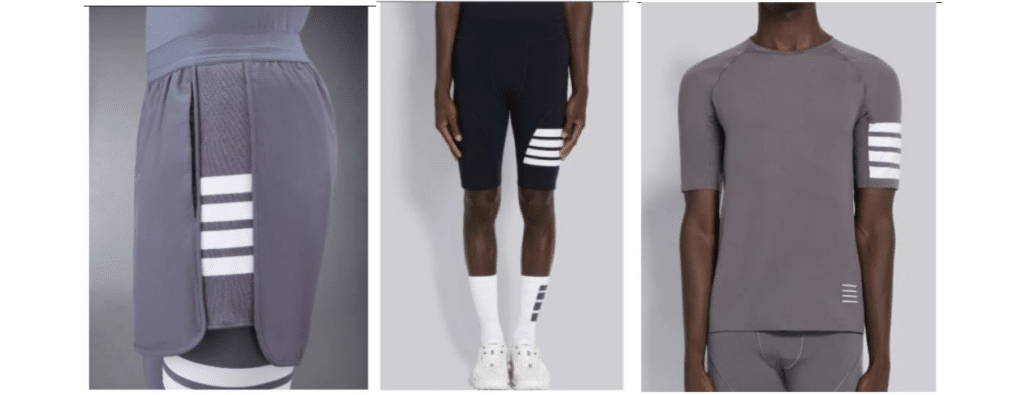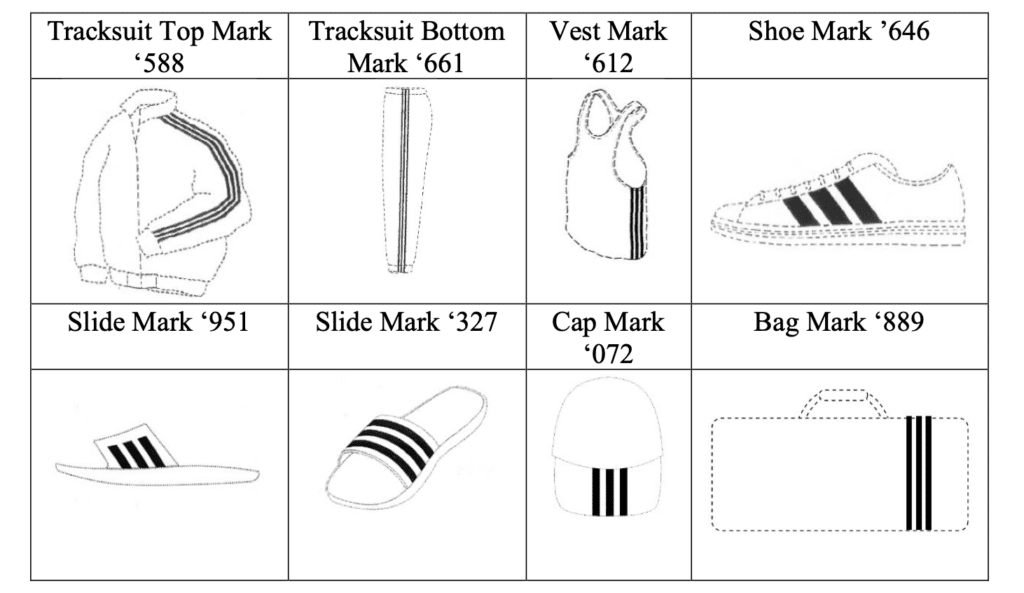Thom Browne nabbed a number of wins in yet another clash with adidas. This time, the parties’ trademark battle played out in front of the English High Court, which invalidated a number of adidas’ UK registrations for its three-stripe trademark. At the same time, the UK High Court’s Mrs. Justice Joanna Smith stated that despite adidas’ arguments to the contrary, consumers would have no problem distinguishing between its three-stripes mark and the four-stripe design utilized by Thom Browne, further weighing in favor of the American fashion brand.
The issues in a nutshell: The latest round of the case – which stems from Thom Browne’s bid to get the UK Intellectual Property Office to cancel an array of adidas trademark registrations – hinged on a few pivotal issues. Primarily, Thom Browne challenged the validity of adidas’ trademarks on the basis that they lacked the necessary clarity and precision for registration and arguing that the sportswear giant’s use of a wide array of stripe-centric permutations creates an unfair monopolistic advantage. Beyond that, the court was tasked with considering whether adidas’ trademarks are sufficiently distinctive (either inherently or as a result of secondary meaning) in the UK market and whether the scope of their use supported the broad protection claimed by adidas.
And finally, on the issue of likelihood of confusion, the crux of a trademark infringement claim, adidas argued that the similarities between its three-stripe marks and Thom Browne’s four-bar design could cause post-sale confusion, while Thom Browne countered that its “Four Bar Design” is a distinct brand signifier within the luxury market, unlikely to be mistaken for adidas’ designs.

> Validity of adidas’ registrations: In her November 22 judgment, Mrs. Justice Joanna Smith found that eight (of sixteen) registrations for adidas’ stripe-centric marks fail to meet the registration requirements, including for “certainty, intelligibility, specificity, precision, accessibility, uniformity, self-containment and objectivity.” She stated that based on the language describing adidas’ marks and/or the graphic representations of the marks in a number of adidas’ registrations, “a competitor and a relevant member of the public would … be left in a state of confusion as to the scope and nature of the mark[s].”
For instance, reflecting on adidas “Tracksuit Bottom Mark,” which consists of “three parallel equally spaced stripes applied to a trouser or short, the stripes running along one third or more of the side of the trouser or short,” Justice Smith disagreed with adidas that “the relevant public will understand that this is a single sign with a limited (and clearly prescribed) degree of variation.”
With regard to adidas’ registration for its “Tracksuit Top Mark,” which covered “three equally spaced stripes, all of the same color, applied to the exterior of the goods covered by the specification, the stripes running down substantially the whole length of the outer lateral surface of the sleeves, legs and/or trunks of the goods, the stripes contrasting with the color of that part of the goods to which the stripes are applied, as illustrated on the form of application,” the court similarly sided with Thom Browne. The problem here, according to Justice Smith, is that the mark “is insufficiently clear, intelligible, precise, specific and accessible,” and would not be “perceived unambiguously or uniformly by the public and it cannot be objectively ascertained.” On the contrary, the court found that the mark’s description makes it “impossible to determine the precise subject of the protection that the mark affords to [adidas].”

The sweeping scope is not an accident, per Justice Smith, who stated that “adidas chose the words it used [to describe] this mark and could have chosen to employ a great deal more precision, [or] alternatively to apply to register different marks encompassing illustrations of how each mark was to appear on particular garments.” Yet, she noted that adidas “did neither of these things,” and instead, opted to seek registration for a mark that “involve[s] a multiplicity of signs that extend beyond any permissible degree of variation.”
While Thom Browne was able to secure cancellations of eight of adidas’ trademark registrations, the court upheld the other eight registrations on the basis that they do not breach identification requirements. Among the registrations that remain standing are ones that relate to adidas sneakers and slides bearing the three-stripe trademark, which the court found to be specifically defined by way of the registration language and corresponding imagery.
> Distinctiveness of adidas’ marks: adidas was triumphant on this issue, as the court held that Thom Browne did “not take issue with adidas’ case as to the extensive use of the marks, nor could it; adidas has provided overwhelming evidence of very substantial use and sales of clothing, footwear and accessories in respect of each of the marks over many years.” At the same time, the court found that adidas produced enough evidence to show that its three-stripe marks had acquired distinctive character as of July 30, 2021, which is when Thom Browne commenced the trademark proceedings at hand.
> Likelihood of confusion: Finally, in furtherance of its infringement claims, adidas argued, among other things, that the difference between three stripes and four stripes “cannot be regarded as important, essentially because it is unlikely to be noticed by the average consumer with an average level of attention.” Adidas also claimed that it is unlikely that the average consumer will take the time to count the stripes or that he or she will be able to make a direct comparison between a Thom Browne product and a product bearing one of its three-stripe marks in a post-sale capacity, making confusion likely.
Unpersuaded, Justice Smith held that “the average, reasonably observant, consumer paying a moderate degree of attention will generally perceive the difference between three stripes and four,” and that even if “he or she were to be given six seconds (as adidas suggests), then I have no doubt that he or she would have no difficulty whatever in perceiving that difference.” Moreover, she stated that “stripes may be depicted in many different ways, and I have no doubt that the average consumer is also able to perceive differences between the appearance of stripes, their width and the distance between them (i.e. their pattern).”
The court also noted that even though Thom Browne and adidas’ marks “have been used in parallel over many years and that the evidence shows they are both the subject of constant media attention and intense commentary and interest on social media,” there is “no real evidence of actual confusion,” an additional factor weighing in favor of Thom Browne.
Thom Browne CEO Rodrigo Bazan praised the outcome before the High Court, saying, “We always believed that Thom Browne has unique designs and an individual brand, and we passionately respect it. Although it has been a very tough period to defend in various jurisdictions, we are very pleased with this latest judgment in the High Court of London.”
Meanwhile, in a statement of its own, a spokesperson for adidas said the company is pleased that the court “upheld key aspects of our trademark protection, specifically ruling that the 3-Stripes mark has a strong reputation and is distinctive of adidas products,” and noted that the case illustrates the “ongoing challenges in protecting intellectual property rights and ensuring fair competition in the marketplace.” The company said it is “carefully review[ing] the findings and will determine our next steps.”
Adidas has long relied on its three stripes marks as a cornerstone of its branding, claiming widespread recognition and global goodwill. Against that background, the company has pursued an aggressive strategy to protect its trademarks, targeting a long list of companies across the globe – including a case against Thom Browne in the U.S. – whose designs it perceives as infringing.
The case is Thom Browne, Inc. v. adidas AG, IL-2021-000046 (EWHC).











